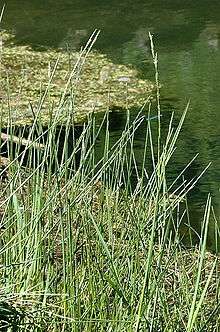Glyceria fluitans
Glyceria fluitans (syns Festuca fluitans, Poa fluitans, Panicularia fluitans), known as floating sweet-grass[1] and water mannagrass, is a species of perennial grass in the genus Glyceria native to Europe, the Mediterranean region and Western Asia and occurring in wet areas such as ditches, riverbanks and ponds.
| Glyceria fluitans | |
|---|---|
 | |
| Scientific classification | |
| Kingdom: | Plantae |
| Clade: | Tracheophytes |
| Clade: | Angiosperms |
| Clade: | Monocots |
| Clade: | Commelinids |
| Order: | Poales |
| Family: | Poaceae |
| Genus: | Glyceria |
| Species: | G. fluitans |
| Binomial name | |
| Glyceria fluitans | |
It has a creeping rootstock, a thick stem which rises to one metre. The leaves are long, narrow and pale green, rough on both sides, often folded at the keel which lies on the surface of the water.
History
Before the 19th century, the grains were widely harvested in Central Europe and Sweden, and traded as far as England.[3] It was cooked and eaten as gruel.[3]
Environmental conservation
Glyceria fluitans is a component of purple moor grass and rush pastures, a type of Biodiversity Action Plan habitat in the UK. This habitat occurs on poorly drained neutral and acidic soils of the lowlands and upland fringe. It is found in the South West of England, especially in Devon.
Gallery
 Glyceria fluitans (1)
Glyceria fluitans (1)
Illustration in:
Jakob Sturm: "Deutschlands Flora in Abbildungen",
Stuttgart (1796)






References
- "BSBI List 2007". Botanical Society of Britain and Ireland. Archived from the original (xls) on 2015-01-25. Retrieved 2014-10-17.
- Archibald William Smith A Gardener's Handbook of Plant Names: Their Meanings and Origins, p. 140, at Google Books
- Nesbitt, Mark (2005). Prance, Ghillean; Nesbitt, Mark (eds.). The Cultural History of Plants. Routledge. p. 47. ISBN 0415927463.
- pages 22–23 of The Observer's Book of Grasses, Sedges & Rushes by Francis Rose,1974, published by Frederick Warne & Co